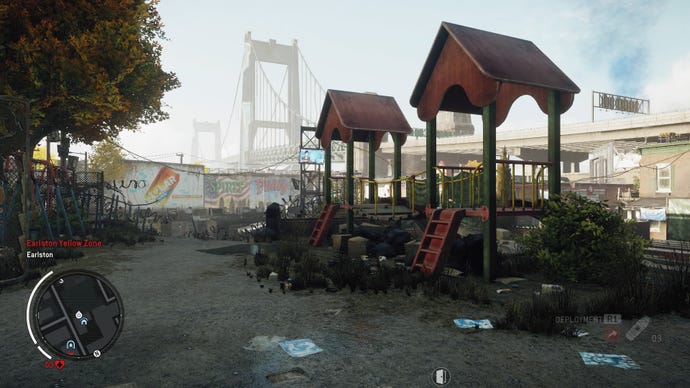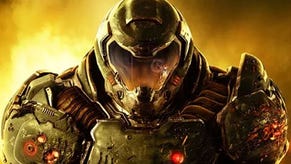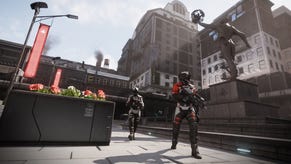Homefront: The Revolution PS4 Review: Ambitious, but Flawed
After spending years in development hell, Homefront: The Revolution has arrived at last. Unfortunately, though, it's not without its issues.
This article first appeared on USgamer, a partner publication of VG247. Some content, such as this article, has been migrated to VG247 for posterity after USgamer's closure - but it has not been edited or further vetted by the VG247 team.
Set in an alternate reality, Homefront: The Revolution presents a world in which North Korea has become a technological powerhouse, and seemingly benign superpower. However, in an almost-plausible, paranoia-inducing plot, the Korean People's Army successfully invades the United States through nefarious means, and subjugates its citizens.
The game takes place in the ruined city of Philadelphia, four years after the occupation. The player takes the role of Ethan Brady, a hero who wants to fight back by igniting a revolution. His story plays out through a series of interconnected missions and activities that see him slowly build the roots of a resistance, and over time undermine the KPA's domination of Philadelphia's populace.
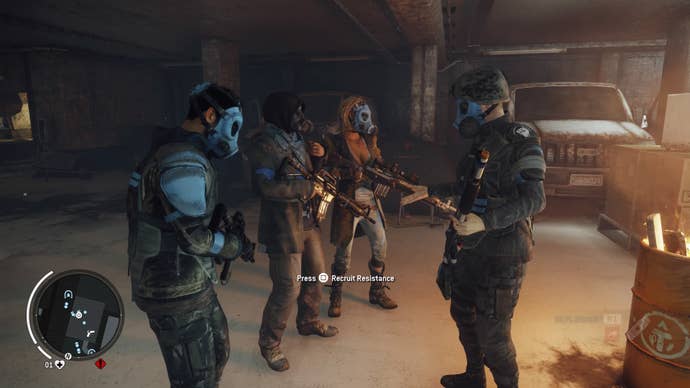
Although it looks and feels like an open-world game, Homefront: The Revolution is actually compartmentalized into a series of zones, each of which contains its own set of missions and dynamically-assigned side jobs. Some areas feature more typical first-person shooter fare that involves activities such as taking on a small army single-handedly, or destroying something like a vehicle or supplies. In others, missions are a little more covert – such as letting prisoners free or stealing a specific item that will help the resistance and generally hinder the occupation forces.
There are safe houses and bases to establish, as well as KPA tech to hack that, if you're successful, fill your local map with items and things to do. The hacking mechanic is a rather simple mini-game that uses the joypads to "tune" into the technology, and once you've got the gist of it, it's really easy to complete – every time you do it.
There are also specific objectives to fulfill to help rally that zone's inhabitants behind the resistance. These include finding radios (which automatically tunes them into resistance programming), helping citizens who are being threatened by KPA forces, and sabotaging pieces of equipment. Each objective you complete incrementally adds to that zone's Hearts and Minds meter, and once full, you have the populace behind you.
The game's areas are all well designed, and range from lively ghettoes through more upscale neighborhoods to bombed-out demilitarized zones. Having never been to Philadelphia, I can't attest to how well the game echoes its architecture and general feel, but the city seems impressively realistic. It's clear that a lot of thought and work has been put into creating Homefront: The Revolution's environment: It's packed full of detail, from interesting building interiors to streets strewn with garbage and rubble.
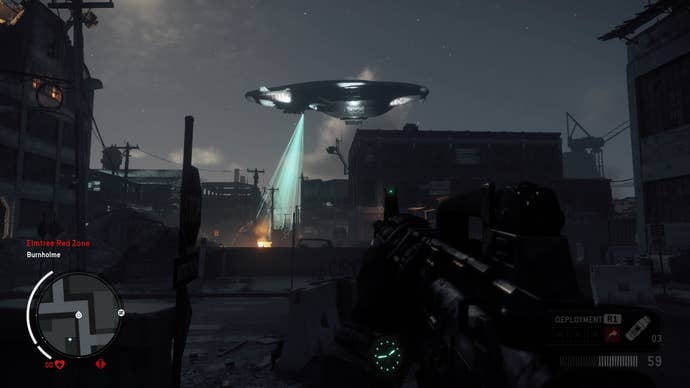
Speaking of the environments, exploring them is one of the game's more challenging aspects. Many of the zones are rife with checkpoints, patrols, security cameras, and drones that are able to identify you as a hostile, and immediately set off a shoot-out that escalates the longer you stay involved. Fortunately, the game features a GTA-like mechanic, and if you flee and keep out of sight from enemies for long enough, they forget about you, and go about their normal business. This can lead to some interesting moments as you run around looking for a safe spot to hang out, but it's not quite as exciting as I hoped it might be. The enemy AI is rather dim, and sometimes you can get away simply by running around a couple of corners, and waiting while the enemy seems to stand on the spot, spinning as they look around. As long as you don't move, they won't either, and if you're patient, the alert meter will run down and you can safely go back to what you were doing. It just feels a little cheesy and incongruous.
The sheer volume of enemy obstacles makes working your way around some of the game's environments quite tough at times, and in some respects Homefront feels like a poor man's stealth game. You're unable to perform any stealth moves other than hiding in trash bins and portable toilets, however, and for the most part you simply need to stay out of the way of enemy forces by taking back alleys, skulking in the shadows, or using other citizens wandering the streets as line-of-sight blockers so you don't get identified.
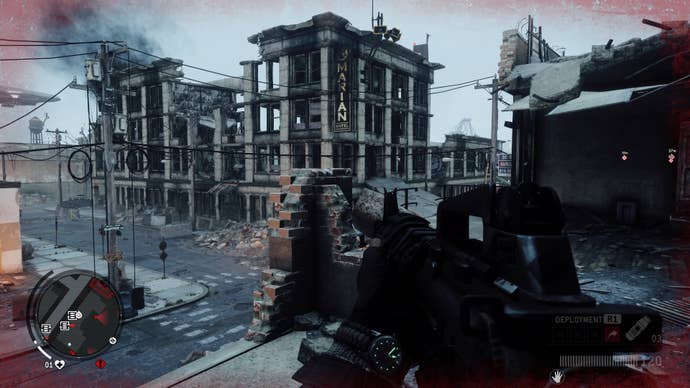
To be blunt, I didn't particularly enjoy this aspect of the game that much. Patrols seem to be random, and it's time-consuming waiting for a group of enemy soldiers to move away from a spot you need to get to. Sure, you can break away and do a side mission, or go interact with an object elsewhere on the map, but sometimes you want to do something specific, and end up having to hang about, waiting for the right moment so you can safely head to that location. This is definitely a game where you need to be patient.
The same is true for combat. I found most shoot-outs were very challenging when I played them conventionally: Homefront's guns generally feel quite loose and not very accurate, while the enemy forces are often overwhelmingly well armed, and will shoot you down with ease. However, I found I could cheese the AI a couple of different ways. At a pinch, heading around a corner and then waiting for enemy soldiers to come looking for me enabled me to pick them off one by one. It was a bit boring doing it this way, but at least it saved me from getting shot and ending back at a safe house (and then having to make my way all the way back to the mission, avoiding yet more patrols). The best tactic, however, was to head upstairs and find a vantage point above the group of soldiers I was fighting, and it was like shooting fish in a barrel. The AI doesn't seem to be very good at shooting upwards, and as long as you can maintain a height advantage – either using stairs or an upper-floor window, you can pick off the enemy with relative ease.
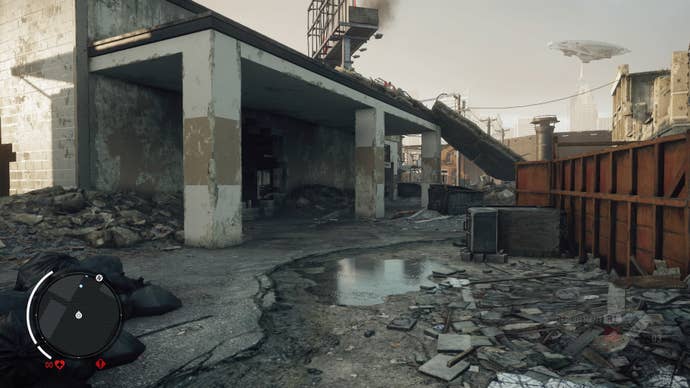
Indeed, once I'd worked out how to properly exploit the enemy AI, my biggest issue became running out of ammo. That unfortunately happens frequently, and is perhaps my biggest frustration about Homefront. Sure, it feels quite realistic to have only a limited amount of ammo, but it's just not much fun when you're in the middle of a firefight and suddenly you no longer have the means to kill the enemy, other than running straight at them and trying to perform a takedown move. Fortunately, you can scavenge ammo (and other items) from the bodies of downed enemies, but sometimes it's just not very practical to do so – especially when you're in the middle of a firefight.
Another element of the game that I found disappointing is its storyline and characters. Homefront's many cutscenes are of decent quality in terms of their looks, but the characterizations and general plot beats aren't particularly inspiring. Ethan never speaks, so there's no real feeling of engagement with other characters – the conversation is all one-way, and you end up not really knowing who he is, or what he's all about. The other characters aren't particularly interesting either, and while there is plenty of plot exposition, it's generally predictable. It all adds up to a game whose story arc just isn't particularly gripping – it's more a means to guide you from place to place and from mission to mission.

On the positive side, one aspect of Homefront that does work well is its crafting and customization elements. Currency is earned in the course of duty that can be spent on items of gear and clothing that deliver different perks. Also, guns can be tweaked and upgraded quite comprehensively with parts to suit your playstyle. The system is well thought through, and there's a definite feeling of progress as you earn pieces of gear that improve your character's arsenal.
There are also plenty of items to find as you wander around the environment, from valuables to stuff like wires and propellant. The former can be traded for currency at certain locations, while it's possible to craft the latter into items such as improvised explosives and Molotov cocktails. These can be very useful, and I found that it was a good idea to stock up on stuff before heading into a mission, since it's possible to craft new items on the fly.
While looking for items, and indeed generally wandering around Homefront's world, some flaws are exposed in terms of the way it's been designed. The game does have some platforming elements, and you're able to clamber up onto roofs and scaffolding. However, positioning your character to climb up walls and objects can sometimes be fussy, and you need to put yourself in just the right spot to be able to shimmy up onto something. This can be very frustrating when you're trying to run away from KPA forces, or perhaps want to quickly climb up onto a vantage point during a firefight, and you end up standing on the spot, nudging the joypad left and right until you're in the perfect place to be able to do so.
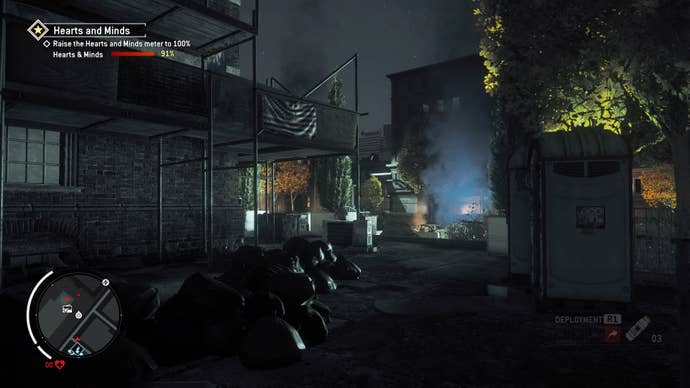
Homefront's multiplayer has the potential to be its strongest asset, although it feels a little underwhelming at launch. It's basically a co-op mode where you can play six different game missions with up to four other players at three different difficulty settings. Before the action begins, you create a character, choose a profession to gain a perk, and equip him or her with the kind of weapon that best suits your style of play, such as assault rifle, shotgun, or sniper rifle.
As you play missions, you earn currency that you can use to buy loot crates that contain a wide variety of different items, from new weapons and gear to cosmetic upgrades. It's a system that's been used in other games successfully, and it works well here. What's disappointing, though, is that it doesn't take long to become very familiar with the maps, and once you've completed them a few times, the game begins to feel like a grind. This is a shame, because I like the idea of leveling up my character and earning gear, and found that working with other players as a team was a really enjoyable way to tackle the game. What's needed is more mission variety – and hopefully that'll happen in the form of additional updates over time.
Ultimately, Homefront is a really ambitious game that doesn’t hit the high bar it sets for itself. Some of its missions are interesting, but are marred by AI that you really need to exploit to stand a chance of success, and shooting action that feels just a little too loose and imprecise. I like the idea of an environment that's dangerous to traverse, but unfortunately there are times when it just gets frustrating trying to move around – particularly when you're close to completing your Hearts and Minds meter, and you get nailed by enemies that you don't even have time to see. Indeed, that's another aspect of the game that's disappointing – its many little glitches and flaws. It just seems it needed more time in development to add polish and knock off its rough edges. Perhaps that'll be addressed in an upcoming patch, but for now, Homefront is not a game I can heartily recommend.
InterfaceGenerally well designed to be straightforward and easy to use.
Lasting AppealIf you can ignore its flaws, the single-player mode offers a stiff challenge. The multiplayer mode is rather limited at launch, but is the most enjoyable aspect of the game.
SoundDecent ambient sound effects, and the music is atmospheric, if not always memorable.
VisualsGood. The environments are rich and interesting, and the people look convincing.
ConclusionHomefront: The Revolution is a very ambitious game that has all the ingredients of a blockbuster, but somehow doesn't quite feel fully-baked. The single-player game has aspects that are interesting and challenging, but unfortunately it's let down by average gunplay and flawed AI. Add to that a multiplayer mode that's fun, but limited in scope, and you have a game that falls short of its considerable potential.
